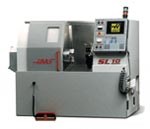Machining The Majority Of Job Shop Parts
This builder has introduced a compact vertical machining center and a compact lathe, both with the same full CNC functionality as larger machines.
In a typical job shop, most of the CNC machines have capacity going to waste most of the time. Look to any of the vertical machining centers in your own shop, and you may see the reason why. Chances are, the job set up on that machine right now doesn’t come close to demanding all of the available travels.
And CNC lathes tell a similar story. Usually, the part takes up only a portion of the maximum possible workpiece diameter.
So why are these oversize machines used for the work? Simple. One reason is that standard-size CNC machine tools are larger than standard-size jobs. Another reason is that orders for bigger parts sometimes do come in . . . and when they do, a shop that makes its living on contract work has to be ready for them.
But when it comes to making the best use of a shop’s available capital, an important consideration is just how often the shop does see these jobs that are large enough to take advantage of a standard-size machine. If the answer is “not all the time,” then the next CNC machine tool the shop purchases may not need to have so much capacity. Instead, those larger jobs can be assigned to an existing, standard-size machine, while the shop saves money by making the next machine it buys more compact. This machine can let the shop increase its capacity to handle just the smaller, more typical parts.
That’s the thinking behind two new machines from Haas Automation (Oxnard, California). The builder has introduced a compact vertical machining center and a compact lathe, both with the same full CNC functionality as larger machines.
The VMC, called “Mini Mill,” features a footprint of about 5 feet by 6 feet, for a machine with XYZ travels of 16 by 12 by 10 inches. Peak spindle rating (three-phase) is 10 hp.
The lathe, called SL-10, has a comparable footprint of 6 feet by 4 feet. Its chuck capacity is 8 inches, bar capacity is 2 inches, and maximum workpiece dimensions are 10.5-inch diameter by 14 inches long. Peak spindle rating is 15 hp.
The small machines can also allow CNC machining capacity to be expanded in shops where floorspace is critically limited. However, in addition to established CNC shops, there is another type of machine shop that a compact CNC machine may benefit. The small price means the machine may be a good fit for some of the smallest shops—particularly those currently not using CNC, or using it only in a limited capacity. A compact machine may offer an easy way to step up to full CNC capability.
This is particularly true in the case of machining center work. The Haas VMC is priced at $29,900. (Price for the lathe is $39,900.) So where a small shop may be preparing itself to commit both capital and floorspace to its next programmable knee mill, for example . . . a small CNC machining center might make a reasonable alternative. MMS
Related Content
Grinding Wheel Safety: Respect The Maximum Speed
One potential source of serious injury in grinding comes from an oversight that is easy to make: operating the wheel in an over-speed condition.
Read MoreChoosing Your Carbide Grade: A Guide
Without an international standard for designating carbide grades or application ranges, users must rely on relative judgments and background knowledge for success.
Read MoreWhen Organic Growth in Your Machine Shop Isn’t Enough
Princeton Tool wanted to expand its portfolio, increase its West Coast presence, and become a stronger overall supplier. To accomplish all three goals at once, acquiring another machine shop became its best option.
Read MoreA New Milling 101: Milling Forces and Formulas
The forces involved in the milling process can be quantified, thus allowing mathematical tools to predict and control these forces. Formulas for calculating these forces accurately make it possible to optimize the quality of milling operations.
Read MoreRead Next
3 Mistakes That Cause CNC Programs to Fail
Despite enhancements to manufacturing technology, there are still issues today that can cause programs to fail. These failures can cause lost time, scrapped parts, damaged machines and even injured operators.
Read MoreThe Cut Scene: The Finer Details of Large-Format Machining
Small details and features can have an outsized impact on large parts, such as Barbco’s collapsible utility drill head.
Read More
.jpg;width=70;height=70;mode=crop)



























